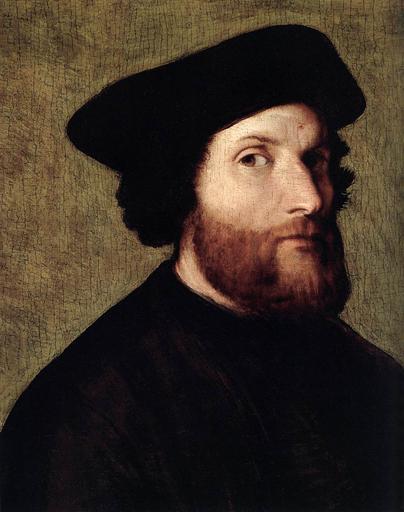MAKE A MEME
View Large Image

| View Original: | Lorenzo_Lotto_-_Self-Portrait_-_WGA13725.jpg (900x1142) | |||
| Download: | Original | Medium | Small | Thumb |
| Courtesy of: | commons.wikimedia.org | More Like This | ||
| Keywords: people portrait Lorenzo Lotto (c. 1480 – 1556) was a Northern Italian painter draughtsman and illustrator, traditionally placed in the Venetian school. He painted mainly altarpieces, religious subjects and portraits. While he was active during the High Renaissance, he already constitutes, through his nervous and eccentric posings and distortions, a transitional stage to the first Florentine and Roman Mannerists of the 16th century. Born in Venice, he worked in Treviso (1503-1506), the Marches (1506-1508), in Rome (1508-1510), Bergamo (1513-1525), in Venice (1525-1549), Ancona (1549) and finally as a Franciscan lay brother in Loreto (1549-1556). As he became a respected painter, he came to the attention of Bramante, the papal architect, who was passing through Loreto (a pilgrimage site near Recanati). Lorenzo Lotto was invited to Rome to decorate to papal apartments. Nothing however survives of his work, as they were destroyed a few years later. This was problably because he had imitated the style of Raphael, a rapidly rising star in the papal court. He had done this before in the Transfiguration in the Recanati polyptych. At the end of his life it was becoming increasingly difficult for him to earn a living. Furthermore, in 1550 one of his works had an unsuccessful auction in Ancona. As recorded in his personal account book, this deeply disillusioned him. As he had always been a deeply religious man, he entered in 1552 the Holy Sanctuary at Loreto, becoming a lay brother. During that time he decorated the basilica of S Maria and painted a Presentation in the Temple for the Palazzo Apostolico in Loreto. He died in 1556 and was buried, at his request, in a Dominican habit. Lorenzo Lotto (c. 1480 – 1556) was a Northern Italian painter draughtsman and illustrator, traditionally placed in the Venetian school. He painted mainly altarpieces, religious subjects and portraits. While he was active during the High Renaissance, he already constitutes, through his nervous and eccentric posings and distortions, a transitional stage to the first Florentine and Roman Mannerists of the 16th century. Born in Venice, he worked in Treviso (1503-1506), the Marches (1506-1508), in Rome (1508-1510), Bergamo (1513-1525), in Venice (1525-1549), Ancona (1549) and finally as a Franciscan lay brother in Loreto (1549-1556). As he became a respected painter, he came to the attention of Bramante, the papal architect, who was passing through Loreto (a pilgrimage site near Recanati). Lorenzo Lotto was invited to Rome to decorate to papal apartments. Nothing however survives of his work, as they were destroyed a few years later. This was problably because he had imitated the style of Raphael, a rapidly rising star in the papal court. He had done this before in the Transfiguration in the Recanati polyptych. At the end of his life it was becoming increasingly difficult for him to earn a living. Furthermore, in 1550 one of his works had an unsuccessful auction in Ancona. As recorded in his personal account book, this deeply disillusioned him. As he had always been a deeply religious man, he entered in 1552 the Holy Sanctuary at Loreto, becoming a lay brother. During that time he decorated the basilica of S Maria and painted a Presentation in the Temple for the Palazzo Apostolico in Loreto. He died in 1556 and was buried, at his request, in a Dominican habit. Lorenzo Lotto - Self-Portrait - WGA13725.jpg Artwork Creator Lorenzo Lotto other date s 1540 Oil on panel size cm 43 35 Institution Museo Thyssen-Bornemisza object history credit line accession number WGA link 13725 http //www wga hu/art/l/lotto/1531-/072selfp jpg http //www wga hu/html/l/lotto/1531-/072selfp html <gallery>Lotto-lorenzo-self-portrait-31862-p jpg</gallery> PD-old-100 painting portrait Italian 1501-1550 Self-portrait by Lorenzo Lotto Lorenzo Lotto (c. 1480 – 1556) was a Northern Italian painter draughtsman and illustrator, traditionally placed in the Venetian school. He painted mainly altarpieces, religious subjects and portraits. While he was active during the High Renaissance, he already constitutes, through his nervous and eccentric posings and distortions, a transitional stage to the first Florentine and Roman Mannerists of the 16th century. Born in Venice, he worked in Treviso (1503-1506), the Marches (1506-1508), in Rome (1508-1510), Bergamo (1513-1525), in Venice (1525-1549), Ancona (1549) and finally as a Franciscan lay brother in Loreto (1549-1556). As he became a respected painter, he came to the attention of Bramante, the papal architect, who was passing through Loreto (a pilgrimage site near Recanati). Lorenzo Lotto was invited to Rome to decorate to papal apartments. Nothing however survives of his work, as they were destroyed a few years later. This was problably because he had imitated the style of Raphael, a rapidly rising star in the papal court. He had done this before in the Transfiguration in the Recanati polyptych. At the end of his life it was becoming increasingly difficult for him to earn a living. Furthermore, in 1550 one of his works had an unsuccessful auction in Ancona. As recorded in his personal account book, this deeply disillusioned him. As he had always been a deeply religious man, he entered in 1552 the Holy Sanctuary at Loreto, becoming a lay brother. During that time he decorated the basilica of S Maria and painted a Presentation in the Temple for the Palazzo Apostolico in Loreto. He died in 1556 and was buried, at his request, in a Dominican habit. | ||||